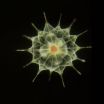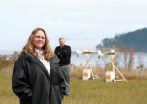(Press-News.org) LONDON, UK—After a decade of joint work and scientific adventure, marine explorers from more than 80 countries, including six scientists from the Marine Biological Laboratory (MBL), today delivered the first global Census of Marine Life revealing what, where, and how much lives and hides in the world's oceans. In one of the largest scientific collaborations ever conducted, more than 2,700 scientists spent over 9,000 days at sea on more than 540 expeditions gathering the data.
As a result of these efforts the scientists discovered that there may be up to 1 billion kinds of marine microbes—more than 100 times more diverse than plants and animals—and as many as 38,000 kinds of microbes in a typical liter of sea water.
A team of researchers from the MBL's Bay Paul Center and their colleagues in 25 countries were among the scientists contributing to the Census through their leadership of the International Census of Marine Microbes (ICoMM), a research project of the larger Census of Marine Life, which focused on the biodiversity of microscopic life forms in the world's oceans.
Over the last six years, ICoMM has amassed more than 25 million genetic sequences from microbes that swim in 1,200 sites around the Earth—from polar bays to tropical seas; from estuaries to offshore; on corals, sponges, and whale carcasses; from surface waters to deep-sea
smokers.
Most of the Earth's biodiversity is microbial in nature, particularly in the oceans. For more than three billion years, these creatures have mediated critical processes that shape the planet's habitability.
In 2006, ICoMM scientists made the startling discovery that while a few microbial species dominate the oceans, most of are very low in abundance. Mitchell Sogin, director of the MBL's Bay Paul Center and ICoMM project leader called this new and unexplored realm of microbial life the "rare biosphere."
Soon after this discovery, Sogin began utilizing a powerful type of DNA sequencer that enabled the analysis of microbial diversity in many more samples, much faster. His new method, called "Pyro-Tagging," attracted additional funding to expand the census. A call to scientists got an enthusiastic and high-quality response, and 40 new labs were chosen to send marine microbial samples to the MBL for sequencing.
"From the very beginning, when we were deciding how we could do a survey of marine microbes, it has been a community effort," says Sogin. "Sample collection is a very expensive game, mostly in terms of running ships, but the submitting labs paid for that, which relieved one financial hurdle for the census." Meanwhile, at the MBL, "we realized right away that we needed bioinformatics capabilities that didn't exist" to handle the data, Sogin says. So they designed databases that allow visualization of microbial diversity in several graphical ways and that combine genetic data with information on the microbes' habitats.
Early on, ICoMM scientists also made the crucial decision to collect not just genetic data on the microbes (which would separate them by type), but also contextual information on where they were found—latitude and longitude, ocean depth, water pH, salinity, and other conditions. What they found is that all microbes are not everywhere. Despite an ability to disperse widely in the oceans, the scientists discovered that characteristic microbial communities can define different water masses in the ocean and can tell us about the health of different ecosystems.
"Believe it or not, this is unique, this coupling of (genetic) diversity data and contextual data," says Linda Amaral Zettler, MBL assistant scientist and ICoMM program manager. "The big payoff is it lets the researchers ask ecological questions about microbial populations that otherwise could not be posed."
Now is the most exciting time, when "things start to unfold, and stories are being told," says Amaral Zettler. "We think our analyses will tell us very interesting stories."
The Census of Marine Life was initiated in 2000 by the Alfred P. Sloan Foundation. During its decade the Census grew to a $650 million global exploration, involving over 670 institutions and more than 10 times the original 250 collaborators. The Census consisted of 17 projects that touch the major habitats and groups of species in the global ocean.
More than 300 leaders of the Census community met October 4 to 7 in London at the Royal Institution of Great Britain, the Royal Society, and Natural History Museum to share their decade of results and consider their implications.
A sequel to the Census will be explored during the London meetings and at the World Conference on Marine Biodiversity next September in Aberdeen, Scotland.
INFORMATION:
The MBL is a leading international, independent, nonprofit institution dedicated to discovery and to improving the human condition through creative research and education in the biological, biomedical and environmental sciences. Founded in 1888 as the Marine Biological Laboratory, the MBL is the oldest private marine laboratory in the Americas. For more information, visit www.mbl.edu.
MBL scientists reveal findings of World Ocean Microbe Census
Project part of historic ten-year marine life census culminating in London
2010-10-05
ELSE PRESS RELEASES FROM THIS DATE:
New report examines university management of intellectual property
2010-10-05
WASHINGTON — The system put in place by the Bayh-Dole Act of 1980 -- which gives universities significant control over intellectual property associated with the results of federally funded research at their institutions – has been more effective than the pre-1980 system in making research advances available to the public and spurring innovation, says a new report from the National Research Council. Nevertheless, the current system needs improvement, said the committee that wrote the report.
"The public investment in research universities has led to a great deal of new ...
Surprise: Scientists discover that inflammation helps to heal wounds
2010-10-05
A new research study published in The FASEB Journal (http://www.fasebj.org) may change how sports injuries involving muscle tissue are treated, as well as how much patient monitoring is necessary when potent anti-inflammatory drugs are prescribed for a long time. That's because the study shows for the first time that inflammation actually helps to heal damaged muscle tissue, turning conventional wisdom on its head that inflammation must be largely controlled to encourage healing. These findings could lead to new therapies for acute muscle injuries caused by trauma, chemicals, ...
Technology transfer and postdoc entrepreneurs
2010-10-05
Post-doctoral researchers see their role as being vital in technology transfer where scientific findings become useful to the local economy, but most have little interest in running their own business once their research fellowship ends. That's the surprising finding of a study published in the International Journal of Knowledge-Based Development.
Edmund Zolnik, a public policy specialist at the George Mason University, in Arlington, Virginia, has surveyed postdoctoral fellows in the US National Capital Region. He found that most saw technology transfer as an important ...
Mechanism involved in addictions and some forms of obesity discovered in U of A lab
2010-10-05
A researcher from the Faculty of Medicine & Dentistry at the University of Alberta has discovered a mechanism underlying some forms of obesity and addictions which could lead to a treatment for both diseases.
When a hungry animal finds food in the wild, it is a rewarding stimulus for the animal and is recognized by the brain by the release of the chemical messenger dopamine. Because narcotics such as cocaine, heroin and amphetamines, and even tasty and highly-caloric foods also cause the release of dopamine and therefore make people feel rewarded, it's clear that dopamine ...
Using cassava to address vitamin A deficiency
2010-10-05
The roots of cassava (Manihot esculenta) serve as the primary source of carbohydrates in the diets of people in many arid regions of the world, including more than 250 million people in sub-Saharan Africa. Unfortunately the roots of commercial cassava cultivars are quite low in micronutrients, and micronutrient deficiencies are widespread in these regions. In addition to programs designed to deliver vitamin supplements, there has been considerable effort aimed at biofortification; that is, increasing the amounts of available micronutrients in staple crops such as cassava. ...
John Theurer Cancer Center to present innovative research at 2 surgical meetings
2010-10-05
HACKENSACK, N.J. (October 4, 2010) — James C. Wittig, M.D. and colleagues will conduct a total of eight research presentations at the upcoming 96th Annual Clinical Congress of the American College of Surgeons and the 65th Annual Meeting of the American Society for Surgery of the Hand. Dr. Wittig, an orthopedic oncologist with extensive experience in performing limb-sparing surgeries, is Chief of the Division of Skin and Sarcoma Cancer of the John Theurer Cancer Center at Hackensack University Medical Center.
The presentations will focus on unique surgical techniques ...
First-of-its-kind study finds alarming increase in flow of water into oceans
2010-10-05
Irvine, Calif. — Freshwater is flowing into Earth's oceans in greater amounts every year, a team of researchers has found, thanks to more frequent and extreme storms linked to global warming. All told, 18 percent more water fed into the world's oceans from rivers and melting polar ice sheets in 2006 than in 1994, with an average annual rise of 1.5 percent.
"That might not sound like much – 1.5 percent a year – but after a few decades, it's huge," said Jay Famiglietti, UC Irvine Earth system science professor and principal investigator on the study, which will be published ...
Montana State team finds rare oasis of life on floor of Yellowstone Lake
2010-10-05
BOZEMAN, Mont. -- Montana State University researchers have discovered a rare oasis of life in the midst of hundreds of geothermal vents at the bottom of Yellowstone Lake.
A colony of moss, worms and various forms of shrimp flourishes in an area where the water is inky black, about 90 degrees Fahrenheit, and a cauldron of nutrients, gases and poisons, the researchers reported in the September issue of Geobiology.
The vent is close to 100 feet below the surface of Yellowstone Lake and a third of a mile offshore in the West Thumb region. The worms and shrimp live among ...
Mayo Clinic takes the lead in clinical research data management
2010-10-05
ROCHESTER, Minn. -- Mayo Clinic is making it easier for industry sponsors and investigators at sites across the country to collaborate with Mayo on complex and groundbreaking research studies and clinical trials.
In a move aimed at optimizing accuracy, speed and efficiency in clinical research, Mayo Clinic has implemented a front-line system of technology for electronic data capture and management, according to Gloria Petersen, Ph.D., Mayo Clinic associate dean for research informatics. "Mayo's Clinical Trials Management System (CTMS) will eliminate the duplication, delays ...
The sky is falling (less) onto Puget Sound
2010-10-05
SEQUIM, Wash. – Most toxic pollution falling onto Puget Sound's waters has decreased – some by as much as 99 percent – below earlier estimates, according to a region-wide study. Despite the overall decline, the study found that industrial areas like Tacoma still have the Puget's Sound's highest air-deposited contamination levels.
The study, by researchers at the Department of Energy's Pacific Northwest National Laboratory and Texas A&M University at Galveston, found the amount of trace metals like arsenic, lead and copper falling onto the Tacoma region have decreased significantly ...
LAST 30 PRESS RELEASES:
The impact of family dynamics on eating behaviour – how going home for Christmas can change how you eat
Tracing the quick synthesis of an industrially important catalyst
New software sheds light on cancer’s hidden genetic networks
UT Health San Antonio awarded $3 million in CPRIT grants to bolster cancer research and prevention efforts in South Texas
Third symposium spotlights global challenge of new contaminants in China’s fight against pollution
From straw to soil harmony: International team reveals how biochar supercharges carbon-smart farming
Myeloma: How AI is redrawing the map of cancer care
Manhattan E. Charurat, Ph.D., MHS invested as the Homer and Martha Gudelsky Distinguished Professor in Medicine at the University of Maryland School of Medicine
Insilico Medicine’s Pharma.AI Q4 Winter Launch Recap: Revolutionizing drug discovery with cutting-edge AI innovations, accelerating the path to pharmaceutical superintelligence
Nanoplastics have diet-dependent impacts on digestive system health
Brain neuron death occurs throughout life and increases with age, a natural human protein drug may halt neuron death in Alzheimer’s disease
SPIE and CLP announce the recipients of the 2025 Advanced Photonics Young Innovator Award
Lessons from the Caldor Fire’s Christmas Valley ‘Miracle’
Ant societies rose by trading individual protection for collective power
Research reveals how ancient viral DNA shapes early embryonic development
A molecular gatekeeper that controls protein synthesis
New ‘cloaking device’ concept to shield sensitive tech from magnetic fields
Researchers show impact of mountain building and climate change on alpine biodiversity
Study models the transition from Neanderthals to modern humans in Europe
University of Phoenix College of Doctoral Studies releases white paper on AI-driven skilling to reduce burnout and restore worker autonomy
AIs fail at the game of visual “telephone”
The levers for a sustainable food system
Potential changes in US homelessness by ending federal support for housing first programs
Vulnerability of large language models to prompt injection when providing medical advice
Researchers develop new system for high-energy-density, long-life, multi-electron transfer bromine-based flow batteries
Ending federal support for housing first programs could increase U.S. homelessness by 5% in one year, new JAMA study finds
New research uncovers molecular ‘safety switch’ shielding cancers from immune attack
Bacteria resisting viral infection can still sink carbon to ocean floor
Younger biological age may increase depression risk in older women during COVID-19
Bharat Innovates 2026 National Basecamp Showcases India’s Most Promising Deep-Tech Ventures
[Press-News.org] MBL scientists reveal findings of World Ocean Microbe CensusProject part of historic ten-year marine life census culminating in London


